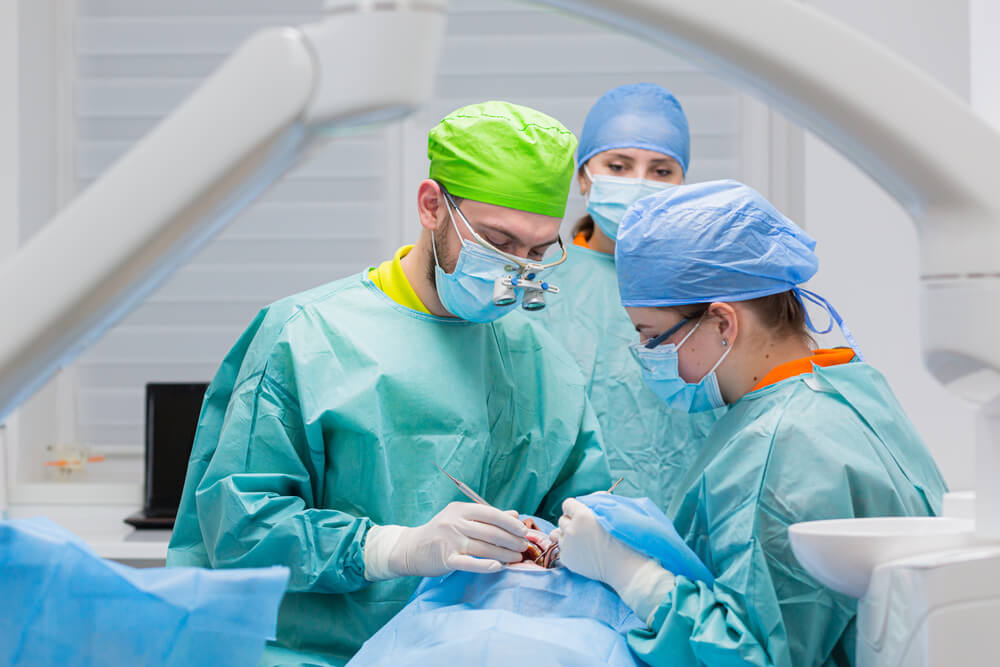Surgical Disimpaction
- Home
- Surgical Disimpaction

Surgical Disimpaction
For the purpose of removing an impacted tooth that is causing pain, infection, or other complications, a surgical procedure known as wisdom tooth disimpaction can be necessary.
Oral and maxillofacial surgeons, who specialize in the diagnosis and treatment of disorders pertaining to the mouth, teeth, and jaws, frequently carry out this procedure.
What Is the Third Molar Affected?
A tooth that does not fully erupt into the mouth is known as an impacted third molar. This is frequently the result of the tooth being misaligned or not having enough room in the jawbone.
Third molars that are impacted are fairly common and can lead to a number of problems, such as infections, cysts, gum disease, and harm to nearby teeth.
In these situations, surgical disimpaction is frequently advised in order to reduce discomfort and stop more issues.
The Process
To guarantee that the patient experiences no pain during the procedure, the oral surgeon will give a local or general anesthetic prior to the procedure.
The impacted tooth will then be visible through an incision made by the surgeon in the gum tissue.
In order to access the tooth, the surrounding bone may also need to be removed. The tooth will be carefully taken out of its socket and separated from the surrounding tissues.
Wisdom Tooth Removal
The goal of the dental procedure known as wisdom tooth removal, or third molar extraction, is to remove the third set of molars that are situated in the back of the mouth. Wisdom teeth usually erupt in late adolescence or early adulthood, and a variety of dental conditions necessitate their removal.
Advantages of Wisdom Teeth Removal at Home
- Preventing Infections
- Gum disease prevention
- Improved Dental Hygiene
- Encourages the Use of Orthodontics
- Maintenance of Neighboring Structures
- Pain Management
Reasons to Remove Wisdom Teeth
Wisdom teeth impact:
Wisdom teeth may become impacted that is, partially or entirely trapped beneath the gum line if they are not given enough room to erupt fully. An infection, discomfort, or harm to nearby teeth can result from impacted teeth.
Crowding:
Wisdom teeth erupting can crowd out existing teeth and cause them to move out of alignment. This may result in orthodontic treatment being necessary or bite issues.
Gum disease or infection:
Wisdom teeth are prone to infection and gum disease because of their position, which makes them difficult to clean. This may cause soreness, edema, and foul breath.
Decay and Cavities:
Wisdom teeth are prone to cavities and decay because they are more difficult to reach and clean. Cavities can cause discomfort and infection if left untreated.
Tumors or cysts:
Rarely, cysts or tumors may form in the wisdom teeth, which could harm the nearby teeth or jawbone.
Process for Wisdom Tooth Removal
1. Consultation and Assessment:
Our dentist will examine your wisdom teeth thoroughly, possibly taking X rays to determine their position, alignment, and overall health. They will go over the necessity of extraction and walk you through the process.
2. Getting ready:
The dentist will go over your medical history, any medications you take, and your options for anesthesia prior to the procedure.
Depending on how complicated the extraction is and how comfortable you are, you may be given local anesthesia, conscious sedation, or general anesthesia.
3. Administration of Anesthesia:
During the procedure, anesthesia ensures your comfort and absence of pain. While conscious sedation or general anesthesia induces a deeper state of relaxation or sleep, local anesthesia numbs the extraction site.
4. Extracting Teeth:
The dentist carefully loosens and extracts the wisdom tooth using specialized tools. If the tooth is impacted or has intricate roots, it may need to be cut into smaller pieces for simpler extraction.
5. Cleaning and, if necessary, suturing:
The area is carefully cleaned to get rid of any debris or infection after the tooth is extracted. If an incision is made, it may be closed with sutures, or stitches, to aid in the healing process.
6. Gauze Positioning:
To stop the bleeding and encourage the formation of a clot, gauze is placed over the extraction site. You’ll be told to gently bite into the gauze.
7. Instructions for Recovery:
In depth post operative instructions from our dentist will include instructions on how to handle pain, swelling, and maintaining good oral hygiene.
- 2, Nandi Dham Society, Opposite Sankalp Hospital, Next to Podar Kids School, Sunrise Park, Vasna Road, Vadodara, Gujarat 390007
- +91 9426020552
